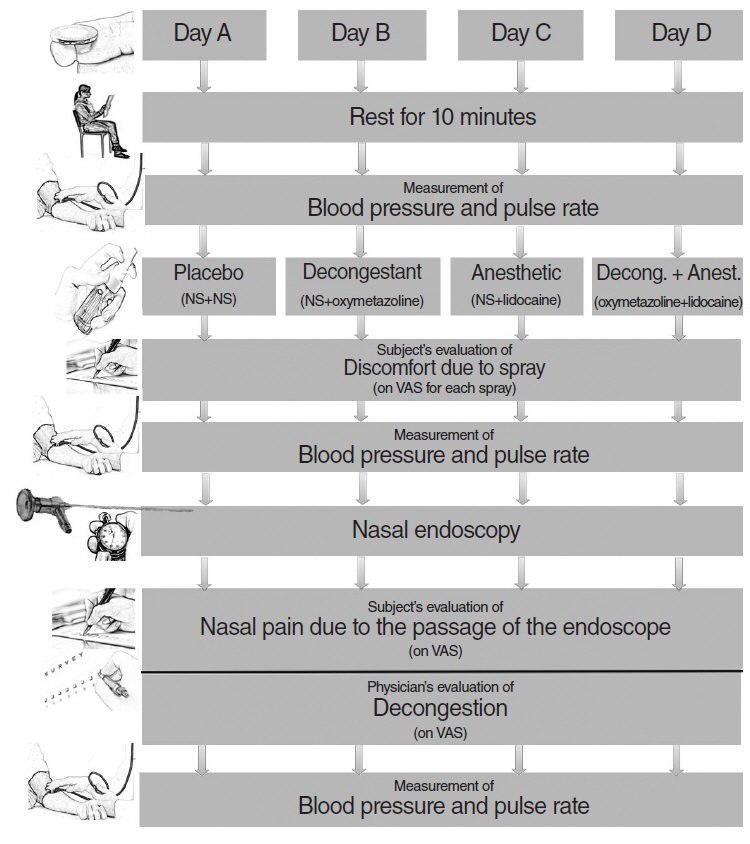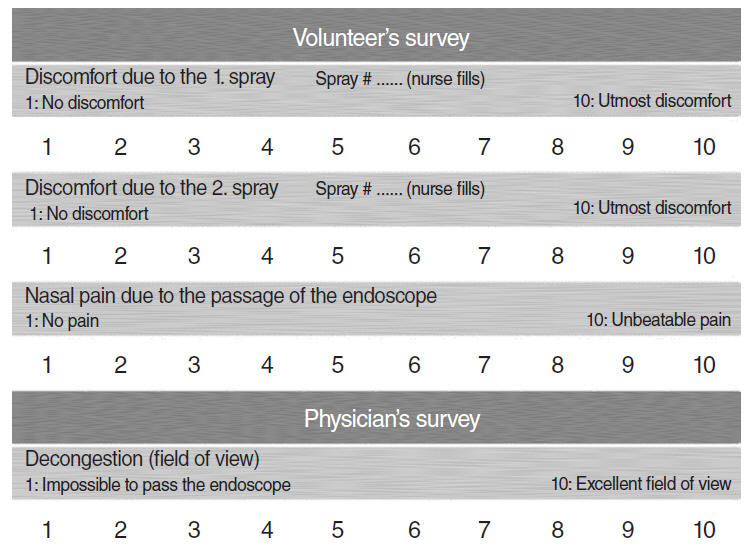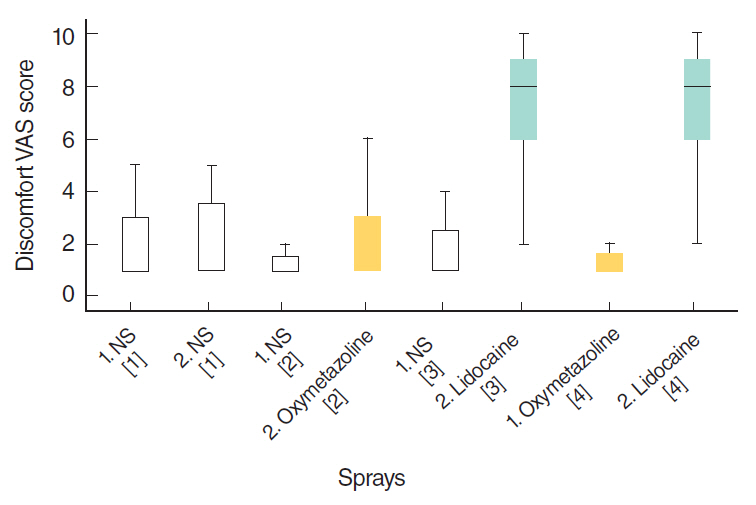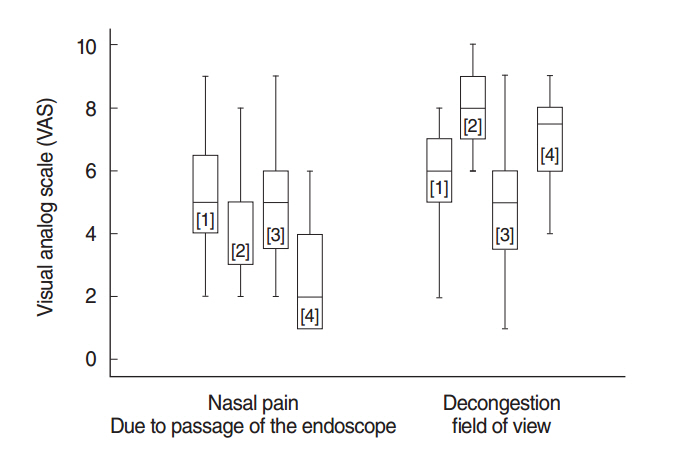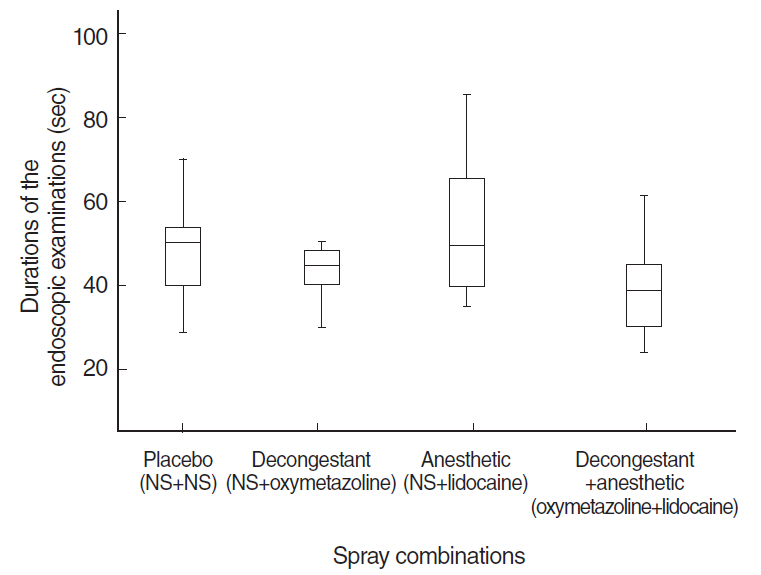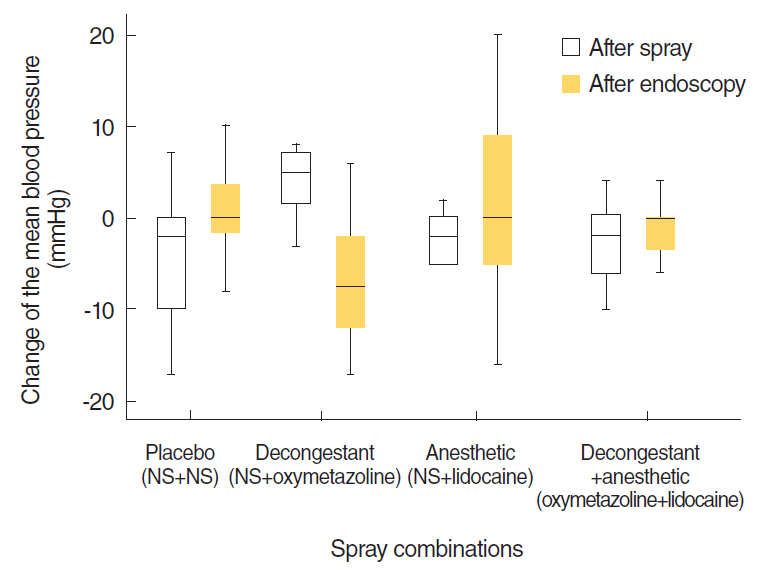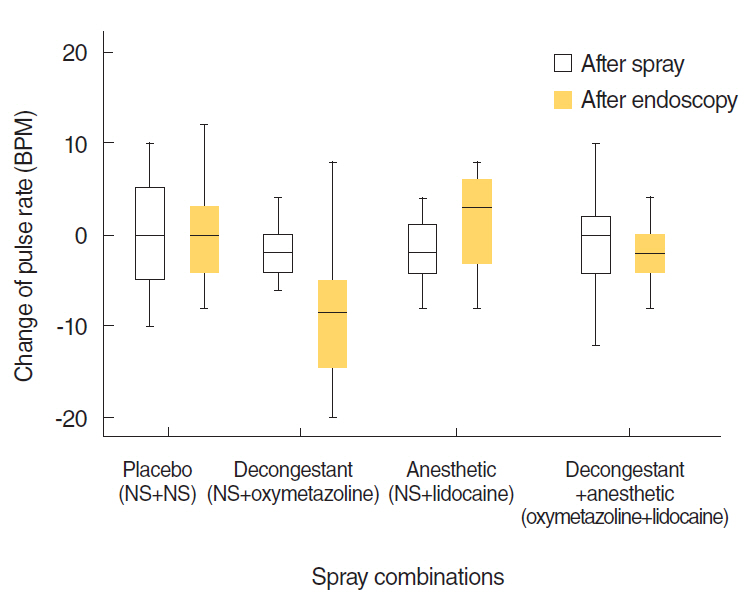Clin Exp Otorhinolaryngol.
2017 Jun;10(2):158-163. 10.21053/ceo.2016.00563.
Premedication Methods in Nasal Endoscopy: A Prospective, Randomized, Double-Blind Study
- Affiliations
-
- 1Department of Otolaryngology, Erciyes University Medical School, Kayseri, Turkey. misahin@erciyes.edu.tr
- 2Department of Otolaryngology, AkdaÄŸmadeni State Hospital, Yozgat, Turkey.
- KMID: 2380434
- DOI: http://doi.org/10.21053/ceo.2016.00563
Abstract
OBJECTIVES
To identify the optimal pharmacological method of preparing patients for nasal endoscopy.
METHODS
Twenty healthy volunteers were enrolled in this prospective, randomized, double-blind study. Four types of medications were applied in their nostrils with binary combinations of spray bottles on four different days in a random order: placebo (normal saline [NS]+NS), decongestant (NS+oxymetazoline), anesthetic (NS+lidocaine), and decongestant plus anesthetic (oxymetazoline+lidocaine). Rigid nasal endoscopy was performed 10 minutes after spray application. The volunteers evaluated the discomfort caused by each spray application, and nasal pain scores due to the passage of the endoscope. The physicians quantified nasal decongestion using a visual analogue scale. Endoscopy duration as well as pulse and mean blood pressure (MBP) before spray application, 10 minutes after the application, and immediately after endoscopic examination were also recorded.
RESULTS
The discomfort caused by lidocaine was significantly higher than that caused by the other sprays (P<0.001). The lowest pain score related to endoscopy was obtained for oxymetazoline+lidocaine (P<0.001). Nasal decongestion was best achieved with NS+oxymetazoline (P<0.001). Endoscopy duration was the shortest for oxymetazoline+ lidocaine (P<0.05). Statistically significant MBP changes were only seen with the application of NS+oxymetazoline (P<0.05). However, neither MBP nor pulse rate change was significant clinically.
CONCLUSION
Application of decongestant and anesthetic sprays together seems to be the best method of pharmacological preparation of patients for nasal endoscopy.
Keyword
MeSH Terms
Figure
Cited by 1 articles
-
Complications of Injection Laryngoplasty
Dong-Hyun Kim, Wonjae Cha
Korean J Otorhinolaryngol-Head Neck Surg. 2024;67(5):263-269. doi: 10.3342/kjorl-hns.2023.01221.
Reference
-
1. Gaviola GC, Chen V, Chia SH. A prospective, randomized, double-blind study comparing the efficacy of topical anesthetics in nasal endoscopy. Laryngoscope. 2013; Apr. 123(4):852–8.
Article2. Midwinter KI, Ahmed A, Willatt D. A randomised trial of flexible versus rigid nasendoscopy in outpatient sinonasal examination. Clin Otolaryngol Allied Sci. 2001; Aug. 26(4):281–3.
Article3. Nankivell PC, Pothier DD. Nasal and instrument preparation prior to rigid and flexible nasendoscopy: a systematic review. J Laryngol Otol. 2008; Oct. 122(10):1024–8.
Article4. Ongkasuwan J, Yung KC, Courey MS. The physiologic impact of transnasal flexible endoscopy. Laryngoscope. 2012; Jun. 122(6):1331–4.
Article5. Frosh AC, Jayaraj S, Porter G, Almeyda J. Is local anaesthesia actually beneficial in flexible fibreoptic nasendoscopy? Clin Otolaryngol Allied Sci. 1998; Jun. 23(3):259–62.
Article6. Singh V, Brockbank MJ, Todd GB. Flexible transnasal endoscopy: is local anaesthetic necessary? J Laryngol Otol. 1997; Jul. 111(7):616–8.
Article7. Latham GJ, Jardine DS. Oxymetazoline and hypertensive crisis in a child: can we prevent it? Paediatr Anaesth. 2013; Oct. 23(10):952–6.
Article8. Cain AJ, Murray DP, McClymont LG. The use of topical nasal anaesthesia before flexible nasendoscopy: a double-blind, randomized controlled trial comparing cophenylcaine with placebo. Clin Otolaryngol Allied Sci. 2002; Dec. 27(6):485–8.
Article9. Georgalas C, Sandhu G, Frosh A, Xenellis J. Cophenylcaine spray vs. placebo in flexible nasendoscopy: a prospective double-blind randomised controlled trial. Int J Clin Pract. 2005; Feb. 59(2):130–3.
Article10. Leder SB, Ross DA, Briskin KB, Sasaki CT. A prospective, double-blind, randomized study on the use of a topical anesthetic, vasoconstrictor, and placebo during transnasal flexible fiberoptic endoscopy. J Speech Lang Hear Res. 1997; Dec. 40(6):1352–7.
Article11. Shrestha BL, Amatya RC. Local anesthesia versus placebo in flexible nasopharyngo-laryngoscopy. J Rhinol-Otol. 2013; 1:52–6.
Article12. Douglas R, Hawke L, Wormald PJ. Topical anaesthesia before nasendoscopy: a randomized controlled trial of co-phenylcaine compared with lignocaine. Clin Otolaryngol. 2006; Feb. 31(1):33–5.
Article13. Johnson PE, Belafsky PC, Postma GN. Topical nasal anesthesia for transnasal fiberoptic laryngoscopy: a prospective, double-blind, cross-over study. Otolaryngol Head Neck Surg. 2003; Apr. 128(4):452–4.
Article14. Kasemsuwan L, Griffiths MV. Lignocaine with adrenaline: is it as effective as cocaine in rhinological practice? Clin Otolaryngol Allied Sci. 1996; Apr. 21(2):127–9.
Article15. De Freitas RP, Hannah BC. Re: nasal and instrument preparation prior to rigid and flexible nasendoscopy: a systematic review. J Laryngol Otol. 2009; Oct. 123(10):1188.16. Sunkaraneni VS, Jones SE. Topical anaesthetic or vasoconstrictor preparations for flexible fibre-optic nasal pharyngoscopy and laryngoscopy. Cochrane Database Syst Rev. 2011; Mar. (3):CD005606.
Article17. Hu CT. Gauze pledgetting versus endoscopic-guided aerosolized spray for nasal anesthesia before transnasal EGD: a prospective, randomized study. Gastrointest Endosc. 2010; Jan. 71(1):11–20.
Article18. Mishra P, Kaushik M, Dehadaray A, Qadri H, Raichurkar A, Seth T. Preparation of nose for nasal endoscopy: cotton pledget packing versus topical spray. A prospective randomized blinded study. Eur Arch Otorhinolaryngol. 2013; Jan. 270(1):117–21.
Article19. Bonaparte JP, Javidnia H, Kilty S. A double-blind randomised controlled trial assessing the efficacy of topical lidocaine in extended flexible endoscopic nasal examinations. Clin Otolaryngol. 2011; Dec. 36(6):550–7.
Article20. Jonas NE, Visser MF, Oomen A, Albertyn R, van Dijk M, Prescott CA. Is topical local anaesthesia necessary when performing paediatric flexible nasendoscopy? A double-blind randomized controlled trial. Int J Pediatr Otorhinolaryngol. 2007; Nov. 71(11):1687–92.
Article
- Full Text Links
- Actions
-
Cited
- CITED
-
- Close
- Share
- Similar articles
-
- The Efficacy of Cimetropium Bromide as a Premedication before Esophagogastroduodenoscopy
- The Influences of Clonidine Premedication on the A-lineTM ARX Index and Hemodynamics during Anesthesia Induction with Propofol
- A Comparison of Nalbuphine, Midazolam, and Buprenorphine As Premedication Agents
- Comparison between the Effectiveness of Oral Phloroglucin and Cimetropium Bromide as Premedication for Diagnostic Esophagogastroduodenoscopy: An Open-Label, Randomized, Comparative Study
- Midazolam as Premedication for Upper Gastrointestinal Endoscopy

